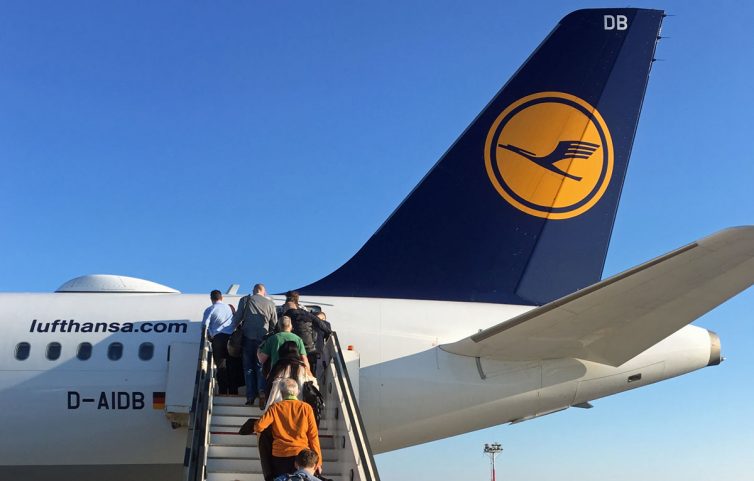
D-AIDB, one of Lufthansa’s newly-equipped IFC aircraft – Photo: JL Johnson | AirlineReporter
Here in the U.S., we have been spoiled by the ubiquity of in-flight connectivity (IFC). A few years ago the IFC saturation rate reached a level affording passengers the opportunity to adjust expectations from being a nice-to-have feature to a downright entitlement. Delta, our on-again, off-again largest domestic carrier, has long been an in-flight WiFi leader, having reached just shy of a 100% IFC-equipped fleet years ago. Thanks to early IFC pioneers like Gogo, with their ATG products, the U.S. has truly had a jump start on other markets.
Because of this, it may be surprising to our U.S. readership that IFC is not terribly common with short-to-medium-range flights in and around Europe. Lufthansa (plus subsidiaries Austrian Airlines and Eurowings) are looking to change that. In partnership with Lufthansa Technik, Honeywell Aerospace, and Inmarsat, these carriers are deploying a new IFC solution at the steady clip of eight planes per week.
I recently had the opportunity to spend some time with Lufthansa Technik to learn about Lufthansa’s new in-flight connectivity solution and even experience it first hand…
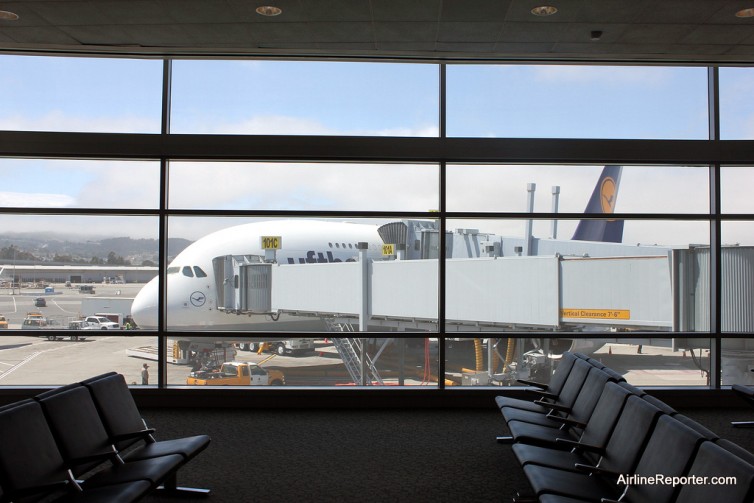
A Lufthansa Airbus A380 at SFO
Traveling from the Bay Area to Europe? Chances are you may find yourself on the Star Alliance trunk route from SFO to Frankfurt. I did recently as I kicked off a trip to Germany, India, and Southeast Asia, celebrating my final few months of freedom between a journalism job and medical school. In my experience, flying to Lufthansa’s ’œFraport’ mega-hub from San Francisco generally meant a trip on United’s venerable ’“ and noticeably aging ’“ 747-400s. While they are beautiful birds from the outside, they don’t make for the best long-haul economy class flights: no seatback screens, no power outlets (although that has since been corrected), and cramped seats, unless you can bump up to Economy Plus or better. Interested in something new, I leapt at the chance to try out Lufthansa’s A380 flight on the same route.
I was glad to be able to book the flight on United ticket stock (ticket number beginning with ’œ016’), which meant I earned both premier qualifying miles (PQMs) and dollars (PQDs) for the flight. With the current UA premier qualifying system, you earn PQMs when you book non-UA ticket stock with Star Alliance partners, but not the PQDs – which are needed for elite qualification.
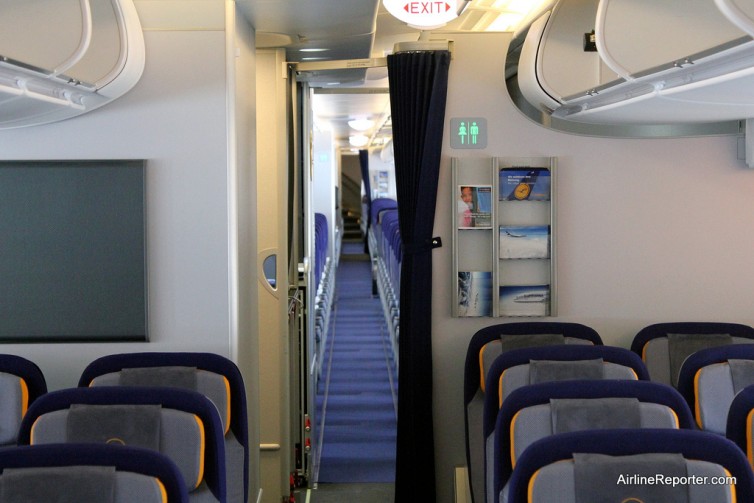
Heading to the back of the plane, to then go upstairs
Curiously, the confirmation code United provided me allowed me to manage my reservation on Lufthansa’s website, but did not work for online check-in. I found a Lufthansa-specific code buried in a separate email. A bit confusing, but not a huge deal. One downside of booking a Lufthansa-operated flight through United is that you are not always able to pick a seat in advance. That ended up being the case for this flight, and I was dreading the possibility of a back-of-the-bus middle seat. Luckily, seat availability was still good when I checked in online, even though the flight ended up being full.
I had only flown the A380 once before (on Emirates) and assumed that the upper deck was first and business class only. To my surprise, there was an ’œupper deck’ tab on the seat selection window during online check-in. It turns out that on Lufthansa’s newest layout for some of its A380s, there is a premium economy section in the front of the lower deck and a small section ’“ five rows, to be exact ’“ of standard economy at the back of the upper deck. I snagged a window seat at the front of the latter section, thrilled that I would finally get upper-deck bragging rights (though without the usual business class accouterments that usually go with it).
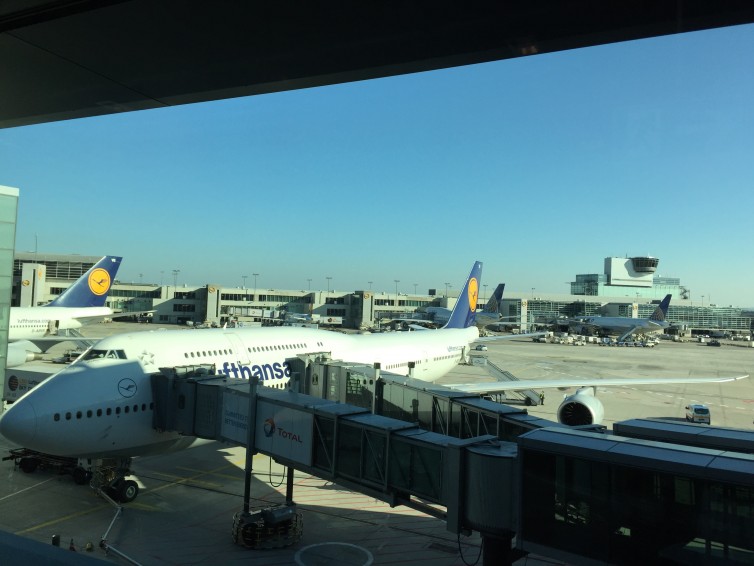
My ride for the next 9 hours, a Lufthansa Boeing 747-8I ’“ Photo: Colin Cook | AirlineReporter
I recently received an invitation to join some friends that were headed to Oktoberfest in Munich, Germany. Given that I consider myself a bit of a beer drinker, I knew I had to join them. I wanted to challenge myself to make the trip as economical as possible, while still traveling in style. I had some points burning a hole in my pocket, and there are often good, premium award options available through some travel partners.
I knew I would have enough points to get me home in business class (because after an eventful Oktoberfest, who would want to fly in coach?), so I needed to find an option to get me to Europe. I ended up booking a direct flight from Seattle to Frankfurt on Condor for a very reasonable $445. The crew on this flight was very friendly and the overall experience was good; just be prepared for a small 30-inch seat pitch on a long-haul flight.
Flying upstairs on a 747 has always been a bucket list item for me ’“ and I was finally able to accomplish it! In my search for award travel, I was able to transfer my Chase Ultimate Rewards points to United Airlines MileagePlus. From there, I booked the flight I wanted: Business Class on a Lufthansa 747-8I. I knew Oktoberfest would be the trip of a lifetime, but I was honestly even more excited at flying upstairs on the ride home.
As I arrived at the Munich airport for my short hop to Frankfurt, I noticed that my flight had been canceled. When I checked with the Lufthansa staff, I found out they had re-booked me on a direct flight from Munich to Chicago.
Now this just wouldn’t do, as that was on an Airbus A340. Most travelers would be happy being on the direct flight, but I asked them to re-book me on another flight so I could still fly on the 747-8I. After some confused looks, I was back in business (pun intended) and booked on the 747.
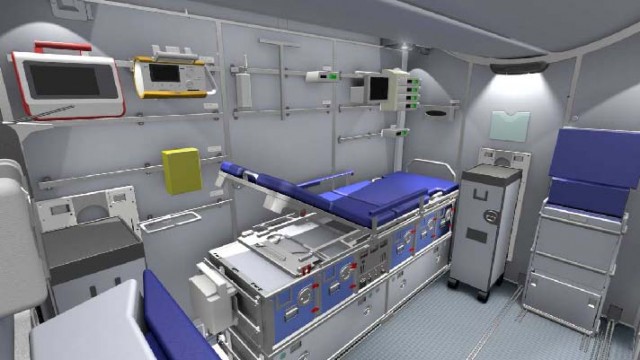
A rendering of the inside of Lufthansa’s Patient Transport Compartment, the “flying ICU” – Image: Lufthansa
Lets face it, nobody wants to need medical care while on board a plane. And yet, with a huge number of people traveling by air everyday, it’s inevitable that it will happen with some regularity. In fact if you travel by air regularly, you have probably heard the flight attendants ask over the PA if there is a “medical professional onboard.”
Any malady that can occur on the ground can happen in the air, and the altitude while on a commercial aircraft can even exacerbate certain medical conditions. That means that some people may be more likely to need medical assistance in the air than they do on the ground.
For German airline Lufthansa, there are about 3,000 passenger medical emergencies that occur on board each year. Of those, an average of 54 emergencies are serious enough that they require the flight to be diverted so that a patient can obtain urgent medical care. I recently had a chance to sit down with the airline and learn how they cope with these situations. Not only is the airline well prepared for any emergency that may arise in flight, they are also ready to treat those who need care before they board the aircraft.
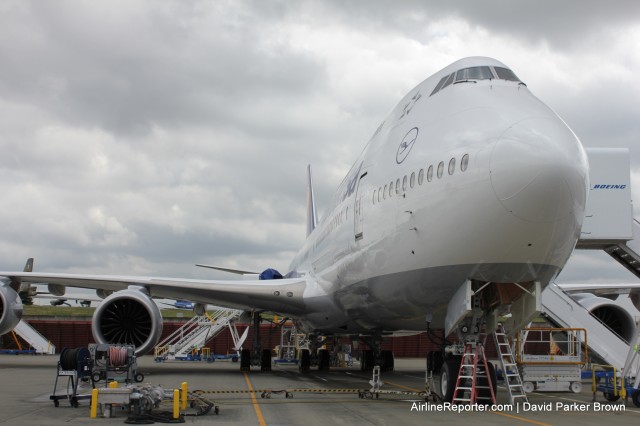
The 1,500th Boeing 747 (70th 747-8) sitting on the flight line at Paine Field
The 747 Jumbo Jet is an iconic aircraft. For years, it was the only double-deck commercial airliner and for many it is a favorite. From its first flight in 1969, the 747 has changed quite a bit. The newest iteration, the 747-8, might sport a similar shape to the original 747 or the 747-400, but it is quite a different beast (more than just LED lighting). This past weekend, the 1,500th 747 was delivered to Lufthansa Airlines. About a week earlier, Boeing took the opportunity to talk about their largest commercial airliner and its future relevance.
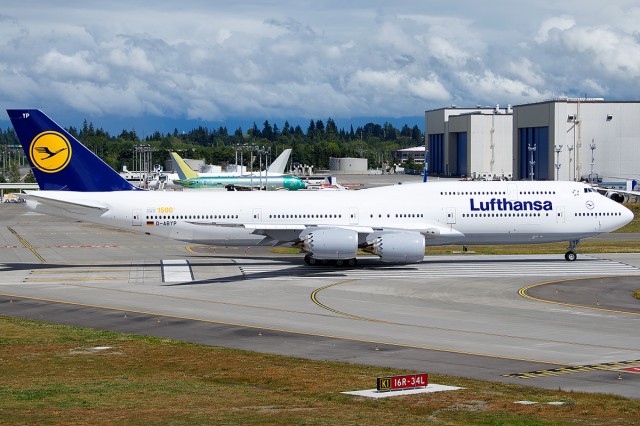
LN1500 lining up for take off – Photo: Bernie Leighton | AirlineReporter
I was invited to Boeing’s factory in Everett to sit down with Eric Lindblad, vice president and general manager of the 747 program, and we had a down-to-earth conversation about where the 747 has been, where it is today, and where Boeing is hoping it is going.
The big message that Lindblad wanted to get across is, “this is not your mother’s 747.” Not only is the 747-8I a very different aircraft than the 747-400, but the 70th 747-8 is much more efficient than the first one, and they plan to keep making it more efficient.






